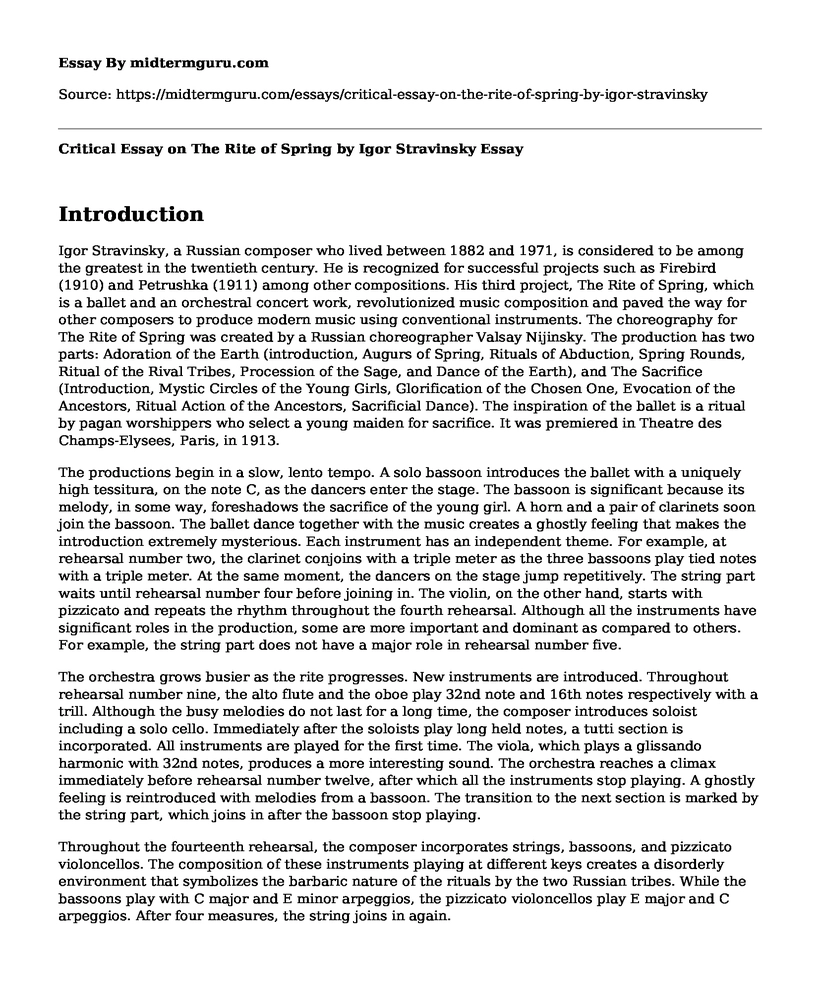Introduction
Igor Stravinsky, a Russian composer who lived between 1882 and 1971, is considered to be among the greatest in the twentieth century. He is recognized for successful projects such as Firebird (1910) and Petrushka (1911) among other compositions. His third project, The Rite of Spring, which is a ballet and an orchestral concert work, revolutionized music composition and paved the way for other composers to produce modern music using conventional instruments. The choreography for The Rite of Spring was created by a Russian choreographer Valsay Nijinsky. The production has two parts: Adoration of the Earth (introduction, Augurs of Spring, Rituals of Abduction, Spring Rounds, Ritual of the Rival Tribes, Procession of the Sage, and Dance of the Earth), and The Sacrifice (Introduction, Mystic Circles of the Young Girls, Glorification of the Chosen One, Evocation of the Ancestors, Ritual Action of the Ancestors, Sacrificial Dance). The inspiration of the ballet is a ritual by pagan worshippers who select a young maiden for sacrifice. It was premiered in Theatre des Champs-Elysees, Paris, in 1913.
The productions begin in a slow, lento tempo. A solo bassoon introduces the ballet with a uniquely high tessitura, on the note C, as the dancers enter the stage. The bassoon is significant because its melody, in some way, foreshadows the sacrifice of the young girl. A horn and a pair of clarinets soon join the bassoon. The ballet dance together with the music creates a ghostly feeling that makes the introduction extremely mysterious. Each instrument has an independent theme. For example, at rehearsal number two, the clarinet conjoins with a triple meter as the three bassoons play tied notes with a triple meter. At the same moment, the dancers on the stage jump repetitively. The string part waits until rehearsal number four before joining in. The violin, on the other hand, starts with pizzicato and repeats the rhythm throughout the fourth rehearsal. Although all the instruments have significant roles in the production, some are more important and dominant as compared to others. For example, the string part does not have a major role in rehearsal number five.
The orchestra grows busier as the rite progresses. New instruments are introduced. Throughout rehearsal number nine, the alto flute and the oboe play 32nd note and 16th notes respectively with a trill. Although the busy melodies do not last for a long time, the composer introduces soloist including a solo cello. Immediately after the soloists play long held notes, a tutti section is incorporated. All instruments are played for the first time. The viola, which plays a glissando harmonic with 32nd notes, produces a more interesting sound. The orchestra reaches a climax immediately before rehearsal number twelve, after which all the instruments stop playing. A ghostly feeling is reintroduced with melodies from a bassoon. The transition to the next section is marked by the string part, which joins in after the bassoon stop playing.
Throughout the fourteenth rehearsal, the composer incorporates strings, bassoons, and pizzicato violoncellos. The composition of these instruments playing at different keys creates a disorderly environment that symbolizes the barbaric nature of the rituals by the two Russian tribes. While the bassoons play with C major and E minor arpeggios, the pizzicato violoncellos play E major and C arpeggios. After four measures, the string joins in again.
The "Ritual of the rival tribes", which is the second episode of part I incorporates two distinct themes to differentiate the two tribes. Therefore, the composer employs different sets of instruments for each group. The first tribe plays the trombone and the trumpet in a syncopated pattern with a long note at rehearsal number 57. The second tribe, on the other hand, uses the horn, bassoon, and the lower strings. The second group plays some homophonic chords in measure 3-4. Once the two tribes are differentiated through the instrumentation, the rest of the orchestra joins, with Stravinsky introducing a new scale-pattern in the upper woodwinds. The systematic descending scale is spotted in rehearsal 57, measure 5-6. At some point, Stravinsky combines themes from the two tribes. In other words, the orchestra plays themes from the two groups simultaneously. As a result, an atmosphere of conflict is created due to the contradicting themes from the two groups.
Conclusion
In summary, "The Rite of Spring", which is Igor Stravinsky's most recognizable work, marked a significant transition to modern music. The Paris performance in 1913, was the first ballet and orchestral music that incorporated a concert-like feel. The composer combined various rhythm, harmony, and texture of different instrument to symbolize the barbaric rituals of the Russian tribes. Although the composition is nationalistic in nature, that is it is inspired by rituals of Russian tribes, it influenced composers of the next generation not to restrict themselves to the traditional way of using musical instruments. Throughout "The Rite of Spring", Stravinsky employs a number of artistic skills such as articulations, bowing techniques, arpeggios, and ostinato ideas to compose a valuable piece of art.
Cite this page
Critical Essay on The Rite of Spring by Igor Stravinsky. (2022, Sep 23). Retrieved from https://midtermguru.com/essays/critical-essay-on-the-rite-of-spring-by-igor-stravinsky
If you are the original author of this essay and no longer wish to have it published on the midtermguru.com website, please click below to request its removal:
- Essay on 21st Century Issues Based on Films: The Matrix, Hairspray, Shawshank Redemption
- Analysis of A View From the Bridge by Cherokee Paul McDonald - Paper Example
- Research Paper on Architecture and Language, Expression and Communication
- Critical Essay on Martin Gansberg's "Thirty-Eight Who Saw Murder Didn't Call the Police"
- Paper Example on Media's Positive Effect on the LGBTQ Community
- China's Film Media in the Digital Age: A Research on Mass Communication Dynamics - Essay Sample
- TV's Effects on Mind: Reduced Brain Activity, Addiction, and More - Research Paper







